65 F. maximum temperature yesterday in the Twin Cities.
48 F. average MSP metro high on March 28.
59 F. high on March 28, 2016.
March 29, 1986: Record warmth occurs with July-like temperatures. A monthly record high of 83 occurs at the Twin Cities.
Surprising Statistics on Severe Weather Risk
"There are three kinds of lies: lies, damned lies and statistics" Mark Twain said. He may have been overly optimistic. Statistics help when gauging relative risk. For example, you're almost 7 times more likely to drown in a bathtub than be struck by lightning.
NOAA statistics since 1986 show you're almost twice as likely to die from complications of extreme heat than tornadoes in the USA. River and flash flooding has claimed almost twice as many U.S. lives as hurricanes.
Tornadoes, hurricanes and blizzards get the air time, the local and national media attention, but flooding and extreme heat takes more lives across America. Vaguely interesting; hopefully the subject of inspired small talk at your next book club.
Meteorologists are at a rare and welcome loss for words: no drama for Minnesota anytime soon; the atmosphere too stable and dry for severe storm outbreaks. A lack of snow means a minimal river flood risk this year. Showers brush southern counties by tonight. Dry weather prevails Thursday PM into Sunday; highs in the 50s into early next week.
Keep a heavy jacket handy. A few more chilly relapses are all but inevitable.
Graphic credit above: NOAA.
3 Storm Chasers Die in Texas Car Crash. ABC News has the details of this tragic story.

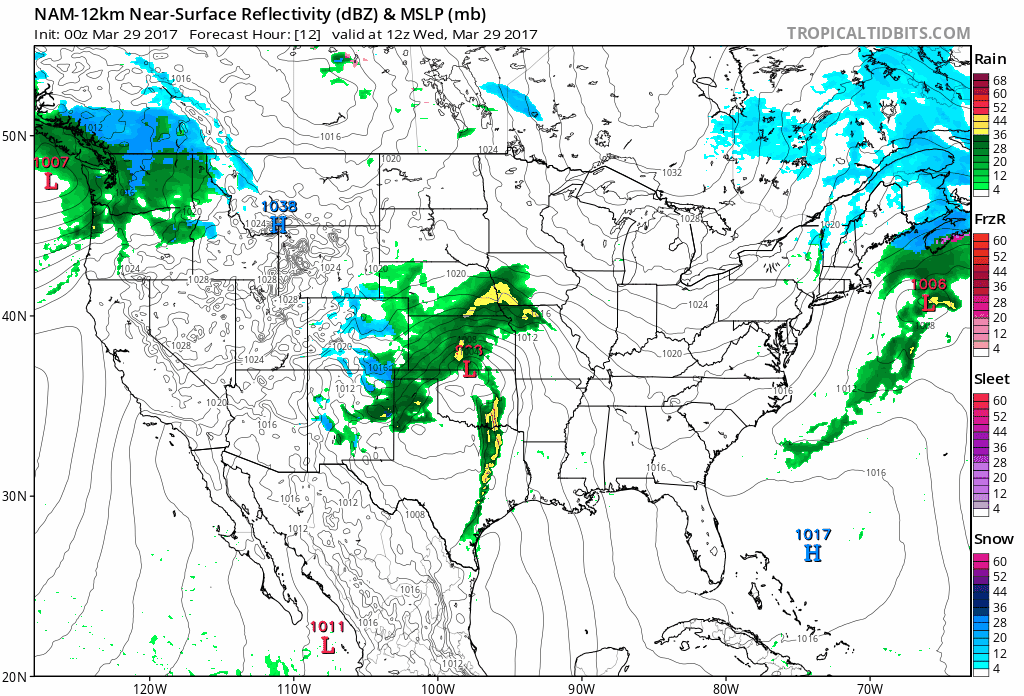
No Rest For the Weather-Weary. The same storm that spawned tornadoes and baseball-size hail across Texas and Oklahoma Tuesday will spread a pinwheel of rain across the Upper Midest and Ohio Valley, eventually pushing heavy wet snow into much of New England by Friday and Saturday. Meanwhile the rains just don't want to quit for the Pacific Northwest with more snow for the intermountain west in the coming days. 12 KM NAM Future Radar product: NOAA and Tropicaltidbits.com.
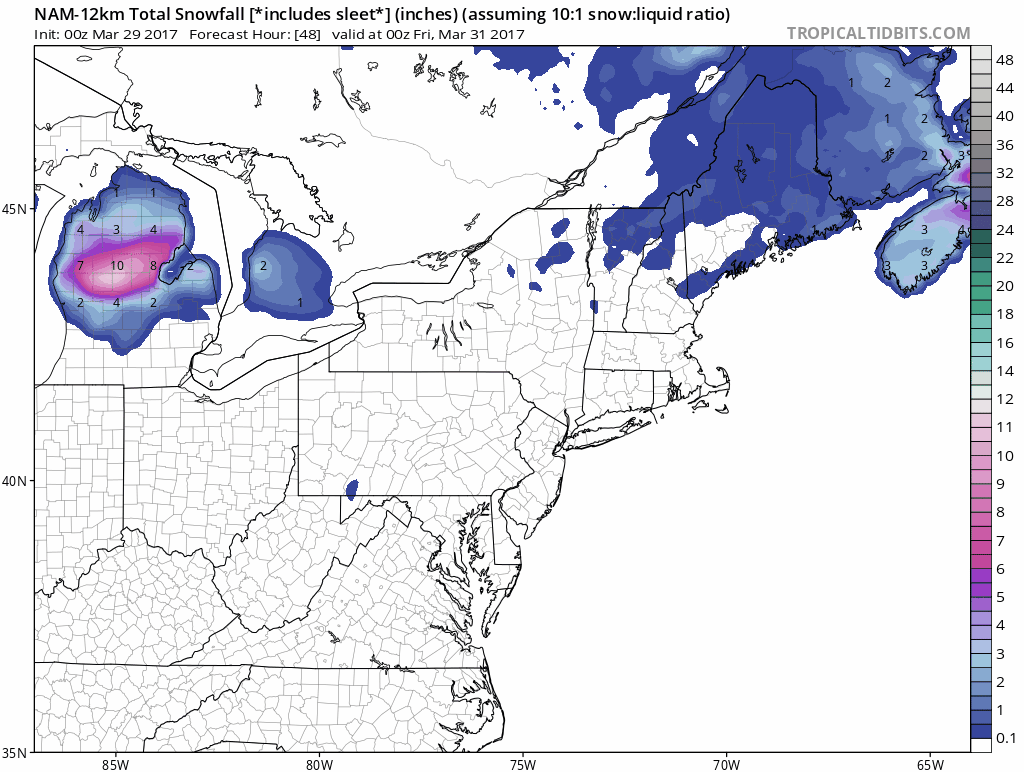
A Bad Meteorological April Fool's Day Joke? We'll see how this unfolds, but models bring a (very) plowable snowfall across central Michigan into upstate New York and much of interior New England. A foot from Albany to Worcester? We'll see, but travel north and west of New York City and Boston may be extremely tricky Friday night into Saturday. 12 KM NAM guidance above.
Forecasts For This Past Winter Were Mostly Awful. Blame the Fickle Pacific Ocean. We were supposed to slide into a La Nina cooling phase, but in recent months the pattern has resembled a severe El Nino pattern with wave after wave of Pacific moisture slamming the west coast. Here's an excerpt of an explainer from Jason Samenow at Capital Weather Gang: "Predicting the weather for winter many weeks before it begins is hard. If any season proved there is a long ways to go in perfecting such long-term outlooks, this winter was it. I am not aware of any outlet in the government, media or private sector which nailed the 2016-17 winter outlook. In fact, some forecasts predicted the opposite of what happened. The National Weather Service and The Weather Company probably had the best outlooks of those I reviewed although they were far from perfect. Across all of the various outlooks, the forecast errors were linked to a Pacific Ocean that did not behave as expected. Storms traveling across it were supposed to mostly pass to California’s north. Instead, time and time again they hit the Golden State head-on, unloading historic amounts of rain and snow, while flooding much of the rest of the nation with abnormally warm air..."
Photo credit: "Chairlift buried in snow, Feb. 22, 2017 at Squaw Valley Alpine Meadows, Calif." (Squaw Valley Alpine Meadows Resort)
Tornadoes Striking at Record Pace in U.S. So Far This Year. It's going to be an extra-long severe and tornado season, at the rate we're going. Here's an excerpt from MLive.com: "...The
storm track in January, February and March has taken strong storms
across the U.S. These strong storms are tracking farther north than
usual for this time of year, resulting in much warmer than normal
temperatures being pulled northward into the Midwest. So the storm track
has been more typical of April or May, even in the middle of winter. As
a result, severe weather amounts have been more typical of April or
May..."
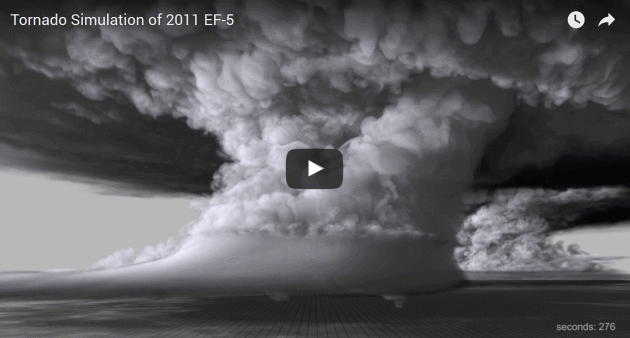
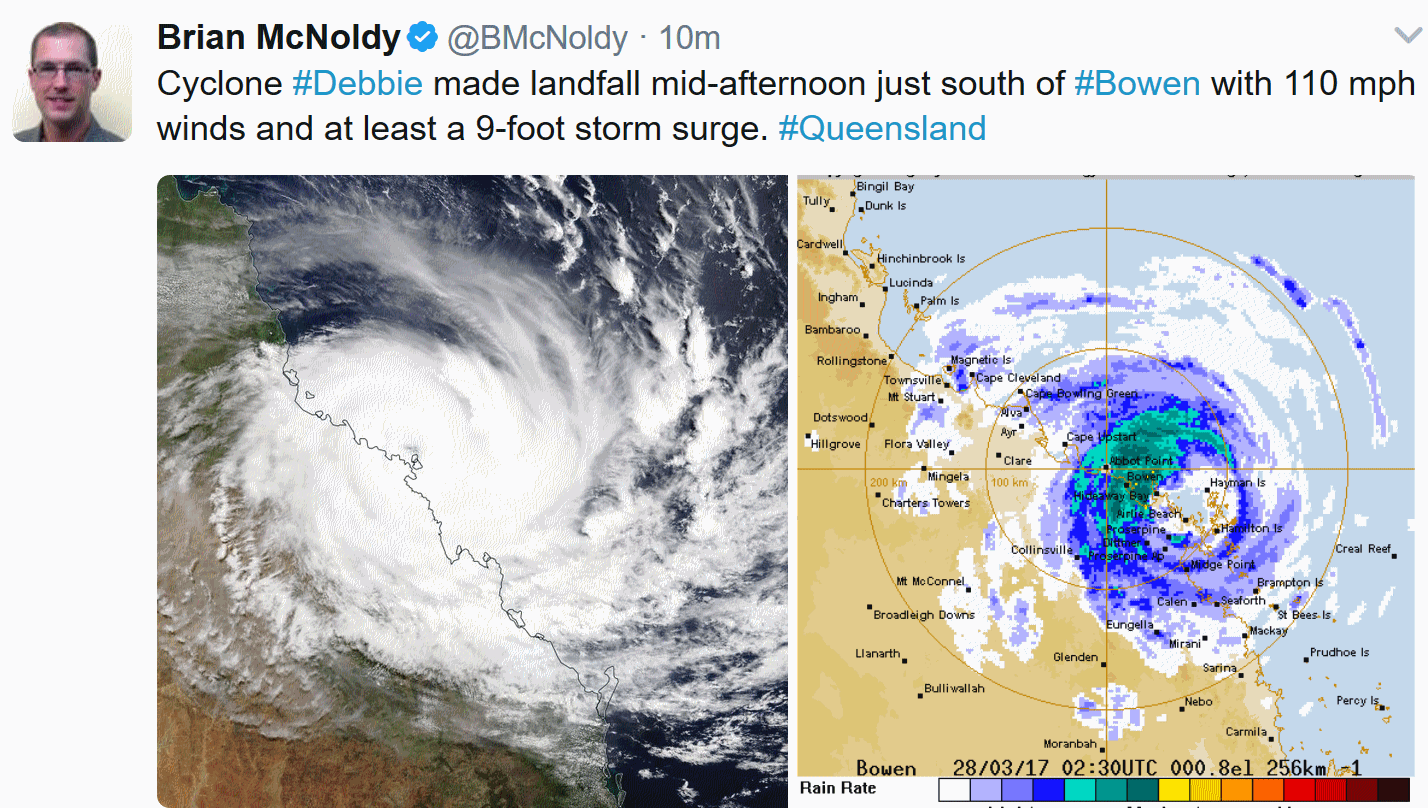 Cyclone Debbie: Deadly Cyclone Batters Australia. BBC News has an update: "A
powerful cyclone has pummelled the north-east Australian coast, causing
major damage, torrential rain and power cuts to tens of thousands of
homes. Cyclone Debbie made landfall between Bowen and Airlie Beach in
Queensland as a category four storm, whipping gusts of up to 263km/h
(163mph). It is moving inland as a category two storm but could cause
damage for hours yet. Prime Minister Malcolm Turnbull said he was aware
of one death so far. Activating a disaster response plan, he stressed
the picture could develop when emergency crews were able to assess the
damage..."
Cyclone Debbie: Deadly Cyclone Batters Australia. BBC News has an update: "A
powerful cyclone has pummelled the north-east Australian coast, causing
major damage, torrential rain and power cuts to tens of thousands of
homes. Cyclone Debbie made landfall between Bowen and Airlie Beach in
Queensland as a category four storm, whipping gusts of up to 263km/h
(163mph). It is moving inland as a category two storm but could cause
damage for hours yet. Prime Minister Malcolm Turnbull said he was aware
of one death so far. Activating a disaster response plan, he stressed
the picture could develop when emergency crews were able to assess the
damage..."

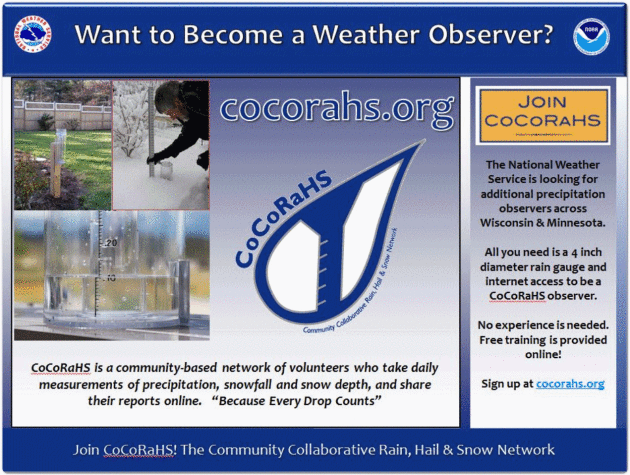

Leigh Orf Creates Super-Storms From the Comfort of His Desk.
Supercomputer simulations of super-cell thunderstorms, the rotating
monsters that often go on to spin up tornadoes, is improving rapidly as
speeds increase and costs continue to come down. Here's an excerpt of an
interview at madison.com: "...I
have to say this is just one simulation, but there are two main
takeaways that I'll give you. Before the tornado forms, there are a
whole bunch of mini-tornadoes. They're not actually called tornadoes,
they're called mesocyclones. They're little spinning whorls of air that
are maybe 100 yards in diameter. They're in the simulation, but you
can't see them in the atmosphere — the air is spinning, but it's not
kicking up debris and there's no cloud...they're kind of scooting into
where a tornado would form. The second thing we've noticed, we gave a
name: we call it a streamwise vorticity current. In a storm, there's
cold air that's formed by the storm itself...the storm is producing this
cold pool of air. One of the things my simulation is suggesting is that
the tornado is made up of air from that cold pool. But there's a
certain feature we've identified that's sort of hard to explain in words
— it's a helically flowing horizontal thing of air, that kind of goes
up and becomes tilted into the supercell..."
WMO "Retires" Two Hurricane Names. Here's an excerpt from a NOAA press release: "You’ve heard the last of Matthew and Otto – at least as Atlantic storm names.
These two storms ravaged the Caribbean so much last year their names
have been retired by the World Meteorological Organization’s Region IV
Hurricane Committee, of which NOAA's National Hurricane Center is a
member. Matthew and Otto are the 81st and 82nd names to be removed from the Atlantic list. Storm names are retired if they were so deadly or destructive that the future use of the name would be insensitive.
Matthew became a category 5 storm on the Saffir-Simpson scale on the
night of Sept. 30, over the central Caribbean Sea at the lowest latitude
ever recorded in the Atlantic Basin..."
Interested in Becoming a NOAA Weather Observer? They're looking for volunteers to help with observations, click here to learn more about CoCoRaHS.

A Century-Old Arctic Shipwreck Could Help us Predict Extreme Weather. FiveThirtyEight has a fascinating tale: "...Today,
the Jeannette’s recovered logbooks tell incredible stories about life,
death, Arctic temperatures, fear and boredom. The records, which
originally existed only in federal archives, are now available to anyone
who wants to read them on a website called Old Weather.
Old Weather is a gathering place for more than 4,500 citizen-sleuths
who are helping climate scientists map our planet’s ancient weather
patterns, for free, one logbook at a time. These volunteers read and
transcribe notes from sailors, hoping to map the mostly unknown history
of our planet’s weather patterns. According to Kevin Wood, an Old
Weather co-founder, examining the past in this way is key to
understanding the earth’s future..."

How Much Does a Cloud Weigh? Check the math, but the calculations described at Mental Floss seem to pan out: "...Next,
figure out how big the cloud is. By measuring a cloud’s shadow when the
sun is directly above it, you can get an idea of its width. LeMone does
this by watching her odometer as she drives under a cloud. A typical
cumulus, she says, is about a kilometer across, and usually roughly
cubical—so a kilometer long and a kilometer tall, too. This gives you a
cloud that’s one billion cubic meters in volume. Do the math with the
density and volume to determine the total water content of the cloud. In
this case, it's 500,000,000 grams of water, or 1.1 million pounds.
That’s a lot of weight to wrap your head around, so LeMone suggests
putting it in more familiar terms, like elephants. That cloud weighs
about as much as 100 elephants. If you’re a Democrat and you’re feeling
partisan, she says, you could substitute 2500 donkeys. If you care more
for dinosaurs than politics, you could also say the cloud weighs about
as much as 33 apatosauruses..."
Great American Eclipse. Check out this amazing web site for everything you need to know for the total solar eclipse coming up on August 21: "On August 21, 2017, millions of people across the United States will see nature's most wondrous spectacle — a total eclipse of the Sun. It is a scene of unimaginable beauty; the Moon completely blocks the Sun, daytime becomes a deep twilight, and the Sun’s corona shimmers in the darkened sky. This is your guide to understand, prepare for, and view this rare celestial event. A total solar eclipse is unlike anything you've seen in your life. As totality approaches, you will see the astonishing sight of day turning to night and the Sun's corona blazing in the sky. This is truly a great American eclipse because totality will sweep the nation from the Pacific to the Atlantic. Nearly everyone in the US can reach this total solar eclipse within one day's drive. An eclipse is a cosmic billiard shot — the Sun, Moon, and Earth line up to reveal the Sun's atmosphere, it's corona. Eclipses on Earth occur only because of an amazing celestial coincidence..."

Photo credit: "There's a reason we put a scientist on our $100 bill."
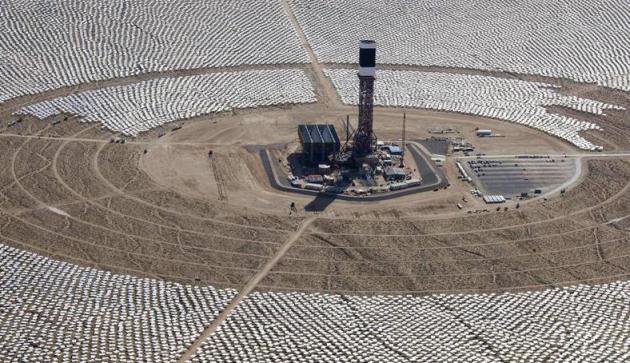
File photo: Zuma Press.
Clean Energy Employs More People Than Fossil Fuels in Nearly Every U.S. State. Here's a clip from ThinkProgress: "Nationally, clean energy jobs outnumber fossil fuel jobs by more than 2.5 to 1, according to a new Sierra Club analysis of Department of Energy jobs data. And when it comes to coal and gas — two sectors President Donald Trump has promised to bolster through his upcoming executive order on energy regulation — clean energy jobs outnumber jobs dealing with those two fossil fuels by 5 to 1. “Right now, clean energy jobs already overwhelm dirty fuels in nearly every state across America, and that growth is only going to continue as clean energy keeps getting more affordable and accessible by the day,” Sierra Club executive director Michael Brune said in a statement..."
Photo credit: AP Photo/Ross D. Franklin.
Photo credit: "Researchers store vials of aging cells in liquid nitrogen for use in future experiments. If work progresses slowly, some also plan to freeze themselves, with instructions to reawaken them once science has finished paving the way to immortality." Photograph by Grant Cornett for The New Yorker.
Could You Give Up TV For a Year? Not sure I could, but I salute the people who have. Here's an intriguing story at The Washington Post: "...Americans
are obsessed with television, spending an average of five hours a day
pointing ourselves at it even as we complain we’re busier than ever. It
rules our lives, whether we admit it or not. A friend of mine claims to
not watch much TV, but whenever I visit her — morning, noon or night —
it’s on. After my husband admitted we hadn’t watched any while on
vacation, a family member was floored: “A whole week without TV?” And
when I showed off my new house, visitors were most excited about the
cable outlet on the back porch; now I can even point my outdoor
furniture at a TV. But for all the time we spend with it, TV doesn’t
repay us very nicely. People who watch more television are generally unhappier, heavier and worse sleepers, and have a higher risk of death over a defined length of time. Studies have found links between children and teenagers who watch a lot of TV and worse attention spans, lower grades and structural differences in brain regions associated with intelligence..."
Why You Should Be Walking 7 Miles a Day - At Least. Does driving 7 miles a day count? Here's a snippet from Esquire: "...But walking any
amount lessened the risk, putting the mail carriers at an advantage.
Mail carriers who walked more than three hours a day had no heightened
risk for heart disease at all—their BMIs, metabolisms, cholesterol
levels, and blood sugar levels were normal. So, according to this
(small, limited) study, 15,000 steps keeps people healthy. For those
curious, 15,000 steps is equivalent to about seven miles of walking.
Easy. People can get 15,000 steps a day "by walking briskly for two
hours at about a four-mile-per-hour pace," lead researcher Dr. William
Tigbe told The Times. (An
average walking pace is three miles per hour.) Another totally
realistic suggestion was "a 30-minute walk before work, another at
lunch, and multiple 10-minute bouts throughout the day..."
Frogpocalypse Now. What is the deal with cane toads in south Florida? Feeling better about Minnesota's mosquitoes after reading a story at Outside Online: "...Cane
toads have these things going for them: they are bigger than other
toads (the biggest cane toad on record weighed 5 pounds 13 ounces,
almost as much as a Kalashnikov rifle); they lay huge numbers of eggs,
perhaps 30,000 in a breeding season (the southern toad, a species they
appear to be displacing in Florida, lays about 4,000); and they are
highly poisonous (their venom, carried in glands in their shoulders, kills animals, and could kill a person, though so far no Floridian is known to have been poisoned by it). On top of all that, they can eat almost anything.
All amphibians are carnivorous, but cane toads stretch the description.
Besides insects, they vacuum up snakes, worms, grubs, snails, mice,
small rats, bats, young birds, other amphibians (sometimes their own
young), pet food, and garbage. They differ from most other frog species
in that they can identify food that is not moving..."
Image credit: Simón Prades.
TODAY: More clouds stream in, showers late. Winds: SE 8-13. High: 54
WEDNESDAY NIGHT: Scattered showers, mainly southern Minnesota. Low: 38
THURSDAY: Damp start, then slow clearing. Winds: E 8-13. High: near 50
FRIDAY: Partly sunny, mostly springy. Winds: NE 5-10. Wake-up: 36. High: 55
SATURDAY: Mix of clouds and sun, pleasant. Winds: SW 5-10. Wake-up: 41. High: 58
SUNDAY: Sunny spells, liking April so far. Winds: S 5-10. Wake-up: 42. High: 59
MONDAY: Unsettled with showery rains. Winds: SE 7-12. Wake-up: 41. High: 54
TUESDAY: Rain lingers, cool and soggy. Winds: SE 10-15. Wake-up: 45. High: 52
THURSDAY: Damp start, then slow clearing. Winds: E 8-13. High: near 50
FRIDAY: Partly sunny, mostly springy. Winds: NE 5-10. Wake-up: 36. High: 55
SATURDAY: Mix of clouds and sun, pleasant. Winds: SW 5-10. Wake-up: 41. High: 58
SUNDAY: Sunny spells, liking April so far. Winds: S 5-10. Wake-up: 42. High: 59
MONDAY: Unsettled with showery rains. Winds: SE 7-12. Wake-up: 41. High: 54
TUESDAY: Rain lingers, cool and soggy. Winds: SE 10-15. Wake-up: 45. High: 52
Climate Stories...
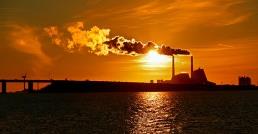
Image credit: "Oregon Governor Kate Brown and Washington Governor Jay Inslee said they plan to "fight back" against President Trump's environmental rollbacks." KING5 TV, Seattle.
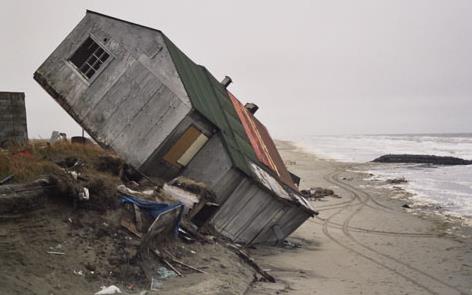
When Is It Time to Retreat from Climate Change? America already has its first climate refugees, due to rising seas, land subsidence and coastal beach erosion in Alaska and Louisiana. This is a question that will be asked with greater frequency and urgency in the years to come. Here's an excerpt at The New Yorker: "...In a paper published today in the journal Nature Climate Change, a trio of Stanford researchers examined twenty-seven recent cases of managed retreat affecting twenty-two countries and 1.3 million people. They found that, regardless of a country’s wealth and level of development, relocations are most likely to happen when a government and its citizens are in accord. In the early two-thousands, for instance, the Dutch farming community of De Noordwaard was “de-poldered”; its seventy-five households were moved, its protective dikes were lowered, and its land was allowed to flood. Residents who initially opposed the retreat came around after repeated inundations, and the government’s initiative helped not only them but also many thousands of others downstream. Likewise, after the Australian state of Queensland suffered a series of catastrophic floods in late 2010 and early 2011, more than two hundred and fifty people in the Lockyer Valley chose to leave, first with local government support and later with assistance from the state and national governments..."
Photo credit: "An aerial view of Isle de Jean Charles, in southern Louisiana." Photograph by William Widmer, REDUX.
CO2 Spike. NASA has more details on carbon dioxide measurement and trends.
Climate Change-Fueled Jet Stream Linked to Brutal Floods and Heat Waves, Says Study.
The jet stream is becoming wavier over time, more sprawling, full
latitude dips and bulges that tend to amplify floods, heat and drought,
according to new research highlighted at InsideClimate News: "...The
Rossby waves shape day-to-day and seasonal weather, said Rutgers
University climate researcher Jennifer Francis, who was not involved in
the study but has done related research on changes in hemispheric wind
patterns. The northward loops carry warm air up from the tropics and
help form high pressure systems, associated with warm and dry weather.
The southward dips pull cold Arctic air down, generating stormy low
pressure areas, she explained. The study found that as greenhouse gases
have increased in the atmosphere, those waves have lingered longer over
particular regions. "Anything that makes those waves more persistent
means the weather is going to be more persistent too, and summer extreme
events are associated with these persistent patterns," Francis said.
The 2010 summer heatwave over Siberia and simultaneous widespread
flooding in Pakistan was a classic example of such a "stuck" pattern,
according to Francis. "What we're learning is there are multiple ways
that global warming is going to affect weather systems in different
regions and different seasons..."

The new research on planetary waves and climate change referenced above is here.
20 Common Myths That Climate Scientists Often Hear. Dr. Marshall Shepherd has done a public service by organizing the 20 biggest (whoppers). Here's an excerpt of a recent post at Forbes:
1. The climate always changes naturally, and we always had extreme weather. This is an accurate statement but misses the point that natural cycles can be altered by anthropogenic processes (Natural growing grass+fertilizer and Major League Baseball-home runs in the steroid era). Natural processes have always and will continue to affect climate. We just have to figure out how this relatively new anthropogenic "ingredient" is modifying the recipe.
2. Ok, the climate is changing but how do we know humans are contributing? There are a couple of good public-focused resources to answer this. One, from Bloomberg, provides a visual graphic to explain relative contributors to climate warming, and the other, from The Economist, explains it with text. For science background, the Intergovernmental Panel on Climate Change (IPCC) report is a good source....
Image credit: NASA.
Image credit: "This animation shows changes in the polar jet stream from June 1, 2015 to July 31, 2015. The jet stream is approximated by crosses. The northerly shift of the jet stream may be linked to a warming arctic, and record melt of the Greenland ice sheet in 2015." (Marco Tedesco/Lamont-Doherty Earth Observatory)
More Warm Spring Days. Not every day, but the trend is more warmth earlier in the warm season, according to Climate Central: "...Spring is getting warmer, on average, as the globe heats up from the increase in greenhouse gases in the atmosphere. As a result, the number of spring days with above-normal temperatures is increasing in many places in the U.S. In an unchanging climate, the number of days above normal and below normal should be relatively balanced and constant through the years. For meteorological spring, that number would be 46 out of the 92 days. In the majority of these cites, the number of days above normal has risen sharply. In some cases, there are more than 10 additional above-normal days than there were a few decades ago..."
What You Can Do About Climate Change. There are lots of things you can do, including voting for pro-science politicians running for local, state and national offices. An article at The New York Times argues that the most important thing you can do is drive a more fuel-efficient vehicle: "...The simple fact is that American drivers are a significant contributor to greenhouse gas pollution, so having a vehicle fleet that burns less fuel can have an outsize impact on total emissions. Though the United States has just 4 percent of the world's population, it is responsible for 14 percent of man-made greenhouse gases that end up in the atmosphere. Transportation accounts for 27 percent of those emissions. And 60 percent result from driving personal vehicles..."
No comments:
Post a Comment